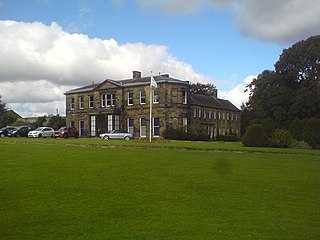
Farnley Hall is a stately home in Farnley, west Leeds, West Yorkshire, England. It is a grade II listed building. It was built in Elizabethan times by the Danbys. The manor is recorded in the 1086 Domesday Book as Fernelei, so it is probable that this house was a replacement for earlier medieval structures.

Little Aston Hall is a Georgian country house in Little Aston, Staffordshire, England.

Brocton Hall is a building of historical significance and is listed on the English Heritage Register. It was built in 1760 by William Chetwynd and remained in the Chetwynd family until 1923 when it was sold to the Golf Club. Today the building is still used as a clubhouse and is also a venue for weddings.
Benjamin Parry was Church of Ireland Bishop of Ossory from 27 January 1678 until his death later the same year.
John Parry was Bishop of Ossory in the Church of Ireland from 1672 until his death.

The Albrighton Hunt is a United Kingdom foxhound pack, with hunting country of around 30-35 miles by 20 miles (32 km) within Shropshire and Staffordshire.
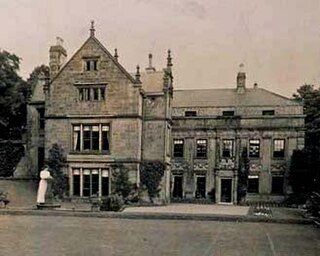
Brymbo Hall, one of Britain's lost houses, was a manor house located near Brymbo outside the town of Wrexham, North Wales. The house, reputed to have been partly built to the designs of Inigo Jones, was noted as the residence of 18th-century industrialist and ironmaster John "Iron-Mad" Wilkinson.

George Brodrick, 4th Viscount Midleton was an Anglo-Irish politician who sat in the House of Commons from 1774 to 1796, when he was raised to the peerage of Great Britain as Baron Brodrick to allow him to sit in the House of Lords.

Edward Parry was Church of Ireland Bishop of Killaloe, County Clare, Ireland from 28 March 1647 until his death 20 July 1650.

Sir Gilbert Talbot of Grafton, KG, was an English Tudor knight, and younger son of John Talbot, 2nd Earl of Shrewsbury and 2nd Earl of Waterford, and Elizabeth Butler.

Chorlton Hall is a country house in the parish of Chorlton, Cheshire, England, some 1.5 miles (2.4 km) northwest of Malpas. The house dates from the 17th century, with additions made in the second quarter of the 19th century. Its entrance front is pebbledashed and it stands on a stone plinth. The roof is slated. The house is in 2½ storeys plus cellars. Across the front are three bays, each with a gable, and with the central bay protruding. On the gables are ball finials. The porch has an ogee-arched entrance. The house is recorded in the National Heritage List for England as a designated Grade II listed building. A stable block and two cottages to the southeast of the house have also been designated at Grade II.

Sir Rowland Cotton was an English politician who sat in the House of Commons at various times between 1605 and 1629.
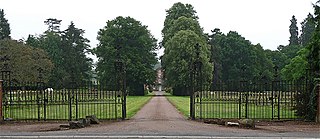
Henley Hall is a building of historical significance and is listed on the English Heritage Register. It was built in about 1610 by the Powys family and then substantially changed in 1772. Additions were again made in the late 19th century. It is a generally a three-storey building in brick with a slate roof. Flanking wings were added at both ends of the original linear building c. 1772 and further major extensions carried out in 1875 and 1907. The hall is surrounded by landscaped and formal gardens covering some 60 hectares. The hall itself is listed grade II* and the orangery, outbuildings, dovecote and Bitterley main gate are listed Grade II. It is situated 2.5 miles (4.0 km) northeast of Ludlow town centre, just off the A4117 road to Cleobury Mortimer. The Ledwyche Brook flows by the estate.

Soughton Hall is a Grade II* listed country house hotel in Sychdyn, Flintshire, Wales. Notable guests that have stayed include Luciano Pavarotti, Michael Jackson and King Juan Carlos I of Spain. William John Bankes inherited Soughton Hall in the 1815.

Hardwick Hall in Sedgefield, County Durham is a building of historical significance and is a Grade II listed building on the English Heritage Register. A major part of it was built in the late 1700s but it is possible that some of it dates from about 1634. It was the residence for many notable people for two centuries. It is now a hotel which provides accommodation and restaurant services and caters for special events particularly weddings.
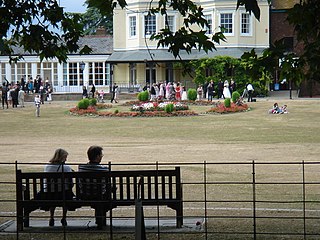
Court Garden in Marlow, Buckinghamshire, England, is a Grade II* listed building on the National Heritage List for England. It was built as a house in about 1758 by Dr William Battie, an eminent physician. It was sold in 1776 to Richard Davenport and remained in the Davenport family until 1894. It was then sold and became the home of the Griffin family for the next thirty years. The house and gardens were bought by public subscription in 1926, with the grounds being made a public park called Higginson Park. Since 1934 the house itself has served as council offices and as a venue for special events.

Morston Hall in the parish of Morston near Holt, Norfolk, is a building of historical significance. The original house was built in about 1640 and cellars and chimneys from it survive. It was substantially altered in the 18th century and a wing was added in the 19th century. It was owned by the Townshend viscounts from Raynham Hall from the 17th century until 1911 and during this time it was tenanted by various notable people. Today it is a hotel. It also caters for special events particularly weddings.
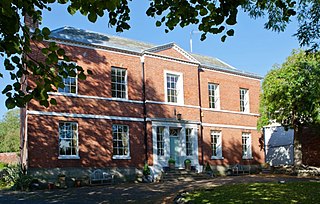
Breedon Hall, Breedon on the Hill in north-west Leicestershire, is a house of historical significance and is listed on the English Heritage Register. In 1620 it was a small timber-framed cottage. Soon after it was bought by the Curzon family and was successively enlarged until 1777 when it was given a new Georgian front. It was the ancestral home of the Curzons for over three centuries and then bought by the Shields family. Today it is owned by the Meynell family and provides bed-and-breakfast accommodation.

Easby Hall near Richmond in North Yorkshire, England is a building of historical significance and is listed on the English Heritage Register. Built in 1729 by the Reverend William Smith, Easby Hall became the home of many notable people for the next two and a half centuries. It now provides bed and breakfast accommodation and is a venue for special events.

Sweeney Hall in Oswestry, Shropshire, is a building that is grade II listed on the English Heritage Register. It was built in 1805 by Thomas Netherton Parker on the site of a 17th-century residence. It was the home of many notable residents over the next two centuries and is today a hotel and wedding venue.




















